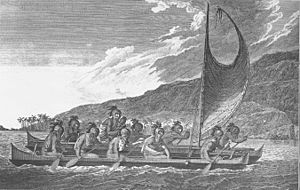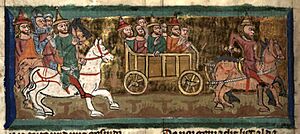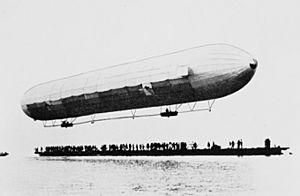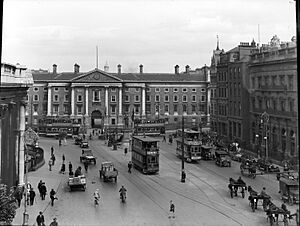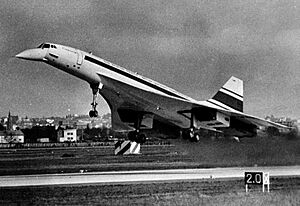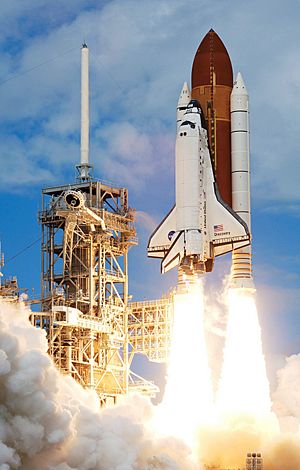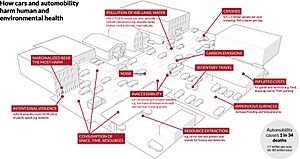Timeline of transportation technology facts for kids
This article explores the exciting history of how people and things have moved around, from ancient times to today! It's a timeline of amazing inventions and ideas that changed transportation forever.
Contents
Ancient Ways to Travel
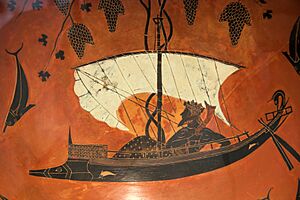
Travel in ancient times was often slow. But people were very clever! They used rivers and animals to help them get around.
Early Boats and Shoes
- Around 20,000 BC, people used simple rafts on rivers.
- By 7,000 BC, the first known shoes appeared, protecting feet for walking.
- About 6,000 BC, people started building Dugout canoes, which were boats made from hollowed-out logs.
Wheels and Animal Power
- In the 4th millennium BC, the earliest vehicles might have been ox carts.
- Around 3,500 BCE, horses were tamed, and the wheel was invented in the Ancient Near East. This was a huge step!
- Toys from the Indus Valley Civilisation (around 3010–1500 BC) show small carts, proving wheels were known.
- By 3,000 BCE, Austronesians built amazing catamarans (boats with two hulls) and outriggers (supports to stop boats from tipping).
- In the Mediterranean, galleys (ships powered by oars) were also developed around 3,000 BC.
- In the 2nd millennium BC, the chariot and the spoked wheel were invented.
- Around 800 BC, Canals were built for transport in Ancient China.
- By 408 BC, the wheelbarrow was used in Ancient Greece.
Travel in the Middle Ages
The Middle Ages saw new inventions that made travel and carrying goods easier.
- In the 5th century, the Horse collar was invented in China. This helped horses pull carts more efficiently.
- By the 6th century, horseshoes were used, protecting horses' hooves.
- The late 7th century saw the first suspension bridge, the Maya Bridge at Yaxchilan.
- Around 800 AD, the streets of Baghdad were paved with tar, making them smoother for travel.
- In the 9th century, the sine quadrant was invented in Baghdad, helping with navigation.
- By the 10th century, large sea-going junk ships were built in China.
- The Kamal, a tool for navigation, was invented in the Arab world in the late 10th century.
- In 1044, the Compass was invented in China, a game-changer for finding direction.
New Ideas and Inventions
- By the 13th century, Rocket missiles were used in China.
- In 1350, the Compass dial was invented.
- Between 1479 and 1519, Da Vinci sketched ideas for a pedalo (a pedal-powered boat).
- The Reisszug, a very old cable railway for goods, was built in Austria between 1495 and 1504. It's considered the oldest funicular (a type of cable railway).
- In the 15th century, Jan Žižka created early armored wagons with cannons, like a very old tank.
- In 1569, the famous Mercator 1569 world map was published, improving navigation.
- By the late 16th century, European sailing ships were good enough to cross oceans reliably.
17th Century Innovations
The 1600s brought new ways to move on land and under water.
- In 1604, the world's first recorded overland wagonway (a track for wagons) was built in England to transport coal.
- In 1616, the first mechanical ropeway for passengers was designed by Fausto Veranzio.
- In 1620, Cornelius Drebbel built the first known submarine, powered by oars.
- In 1644, Adam Wybe built the world's first cable car with multiple supports.
- In 1655, Stephan Farffler invented a self-propelled wheelchair.
- In 1662, Blaise Pascal invented a horse-drawn public bus with a regular route and fare.
- In 1672, Ferdinand Verbiest built what might have been the first steam-powered model car.
18th Century Transport Advances
The 1700s saw the beginning of steam power and flight!
- In 1716, Emanuel Swedenborg created the first idea for a hovering vehicle.
- In 1720, the Differential gear was invented, which helps wheels turn at different speeds.
- In 1731, the Sextant was first used to accurately find latitude at sea.
- In 1733, William Kent developed an early stroller for babies.
- In 1740, Jacques de Vaucanson showed off his clockwork-powered carriage.
- The 1760s saw the invention of Inline skates.
- In 1761, the Marine chronometer was invented, allowing sailors to find longitude accurately.
- In 1769, Nicolas-Joseph Cugnot demonstrated his steam-driven artillery tractor.
- In 1776, the Turtle, the first military submarine to try an attack, was built.
- In 1779, The Iron Bridge was built in Shropshire, a famous early iron bridge.
- In 1783, the first parachute was invented.
- Also in 1783, the Montgolfier brothers launched the first hot air balloons, starting "Balloonomania."
- Later in 1783, Jacques Charles and the Robert brothers launched the first Hydrogen balloon.
- In 1784, William Murdoch built a working model of a steam locomotive carriage.
- In 1789, the pedal-powered tricycle was invented by Blanchard and Maguier.
- The 1790s saw "Canal Mania," a time of intense canal building in England and Wales.
19th Century: The Age of Steam and Rails
The 1800s were a time of huge change, especially with the rise of steam engines and railways.
Early 19th Century Innovations
- In 1801, Richard Trevithick ran a full-sized steam 'road locomotive'.
- In 1803, Trevithick built his 10-seater London Steam Carriage.
- Also in 1803, William Symington's Charlotte Dundas, the world's first practical steamboat, made its first trip.
- In 1804, Trevithick built a prototype steam-powered railway locomotive.
- In 1807, Robert Fulton's North River Steamboat, the world's first commercially successful steamboat, made its first trip.
- Also in 1807, the Swansea and Mumbles Railway started the world's first passenger horsecar tram service.
- In 1812, Matthew Murray's Salamanca became the first commercially successful self-propelled engine on land.
- In 1814, George Stephenson built the first practical steam-powered railway locomotive, "Blutcher."
- In 1816, Baron Karl von Drais invented the Bicycle.
- In 1819, the SS Savannah was the first ship to cross the Atlantic Ocean partly using steam power.
- Also in 1819, Denis Johnson invented the kick scooter.
- In 1825, Stephenson's Locomotion No. 1 ran on the Stockton & Darlington Railway, the first public railway.
- In 1829, the Rainhill Trials found the best steam engine for the Liverpool Manchester line, won by Robert Stephenson's Rocket.
- In 1830, the Liverpool and Manchester Railway opened. It was the first public transport system without animals, with timetables, and proper stations.
- In 1837, the first electric locomotive was built by Robert Davidson in Scotland, powered by batteries.
- In 1838, Isambard Kingdom Brunel's SS Great Western, the first purpose-built transatlantic steamship, started regular service.
- The 1840s saw "Railway Mania" in the UK and Ireland, with thousands of miles of railway lines built.
- In 1849, Sir George Cayley's gliders achieved brief flights.
Late 19th Century Developments
The late 1800s brought elevators, electric trams, and the first cars.
- In 1852, Elisha Otis invented the safety elevator.
- In 1853, Sir George Cayley built and showed the first heavier-than-air aircraft (a glider).
- In 1863, London's Metropolitan Railway opened as the world's first underground railway.
- In 1867, the first modern motorcycle was invented.
- In 1868, the Safety bicycle was invented, which looked more like modern bikes.
- Also in 1868, George Westinghouse invented the compressed-air brake for trains, making them much safer.
- In 1875, the world's first electric tram line operated in Russia.
- In 1880, Werner von Siemens built the first electric elevator.
- In 1881, the world's first commercially successful electric tram opened in Germany.
- In 1882, the trolleybus was demonstrated in Berlin.
- In 1884, Thomas Parker built a practical electric car.
- In 1885, Karl Benz invented the first car powered by an internal combustion engine, the Benz Patent Motorwagen.
- In 1890, the City and South London Railway became the world's first deep underground "tube" railway to use electric power.
- In 1893, Recumbent bicycles (where you recline) were invented.
- Also in 1893, the first moving walkway appeared at the World's Fair.
- In 1894, the Hildebrand & Wolfmüller became the first motorcycle available for people to buy.
- In 1895, the first motorbus (a bus with an engine) ran in Germany.
- In 1896, Jesse W. Reno built the first escalator at Coney Island.
- In 1897, Charles Parsons' Turbinia, the first ship powered by a steam turbine, made its debut.
- Also in 1897, the first electric bicycle was likely built by Hosea W. Libbey.
- In 1899, the Lohner-Porsche Mixte Hybrid was the world's first hybrid vehicle.
- Also in 1899, Ferdinand von Zeppelin built the first successful airship.
20th Century: Flight, Cars, and Space
The 1900s brought incredible changes, from airplanes to space travel.
Early 20th Century Milestones
- In 1903, the Wright brothers made the first motor-driven airplane flight.
- Also in 1903, the Diesel engine was tested in a canal boat. The first diesel-electric ship, the Vandal, was launched.
- In 1908, Henry Ford started mass-producing cars with the Ford Model T, using the assembly line method.
- In 1910, the Fabre Hydravion became the first seaplane.
- In 1911, the Selandia was launched, the first ocean-going ship powered by a diesel engine.
- In 1912, the world's first diesel locomotive operated in Switzerland.
- In 1915, the first hovering vehicle, the Luftkissengleitboot Hovercraft, was created. It could only travel on water.
- Also in 1915, the Motorized scooter was invented.
- In 1916, the first tank prototype, nicknamed "mother," was created during World War I.
- In 1926, Robert H. Goddard launched the first liquid-fueled rocket.
- In 1935, the DC-3 made its first flight, becoming a very important transport aircraft.
- In 1939, the first rocket-powered aircraft, the Heinkel He 176, took flight.
- Also in 1939, the first jet engine aircraft, the Heinkel He 178, took flight.
- In 1947, Chuck Yeager in the Bell X1 completed the first supersonic (faster than sound) manned flight.
Late 20th Century Innovations
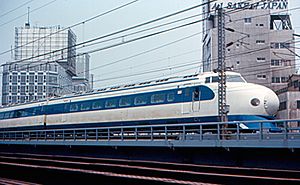
The second half of the 1900s saw jet airliners, nuclear ships, and the start of space exploration.
- In 1952, the de Havilland Comet became the first commercial jet airliner.
- In 1955, the first nuclear-powered vessel, the submarine USS Nautilus, was launched.
- In 1956, the SR.N1, the first modern hovercraft, was demonstrated.
- In 1957, Sputnik 1 became the first artificial satellite launched into orbit.
- Also in 1957, the Gateway City, the world's first purpose-built container ship, started service.
- In 1959, the first modern fuel cell vehicle was a modified farm tractor.
- In 1961, Vostok 1, the first crewed space mission, orbited Earth with Yuri Gagarin.
- In 1964, the Shinkansen (bullet train) in Japan became the first high-speed rail.
- In 1969, the Boeing 747, the first commercial widebody airliner, made its first flight.
- Also in 1969, NASA's rocket technology made the first crewed Moon landing a reality.
- In 1971, Salyut 1, the first space station, was launched by the Soviet Union.
- In 1976, Concorde made the world's first commercial passenger-carrying supersonic flight.
- In 1981, the Space Shuttle made its maiden flight.
- In 1983, the Véhicule Automatique Léger in France became one of the first fully driverless metro trains.
- In 1985, the Sinclair C5, an electric battery-powered velomobile (a bike with a shell), was launched.
- In 1994, the Channel Tunnel opened, connecting England and France by rail.
- In 1997, Maglev train prototypes (which float above the tracks) were tested in Japan.
- Also in 1997, the Toyota Prius became the first mass-produced full hybrid car.
- In 1998, Deep Space 1, the first ion-propulsion spacecraft, was launched.
21st Century: Smart and Green Transport
The 2000s have focused on making transport smarter, more efficient, and better for the environment.
Modern Transport Innovations
- In 2002, the Segway PT, a self-balancing personal transport device, was launched.
- In 2003, Concorde made its last passenger flight.
- In 2004, the Shanghai Maglev Train, the first commercial high-speed Maglev train, started operating.
- Also in 2004, the Metrocable (Medellín) became the first modern urban cable car for public transport.
- In 2008, the Tesla Roadster was the first mass-produced electric car using lithium-ion batteries.
- The 2010s saw the rise of Mobile apps for finding and booking transport like carsharing and bike sharing.
- In 2010, ULTra (rapid transit), the first modern commercial Personal Rapid Transit system, started operations at Heathrow Airport.
- In 2015, China demonstrated the world's first hydrogen fuel cell vehicle tramcar.
- Also in 2015, Navya SAS launched the first autonomous bus.
- In 2016, the DLR HY4 made the first hydrogen fuel cell-powered passenger aircraft flight.
- In 2018, the first driverless trams in Potsdam were tested in Germany.
- Also in 2018, the Toyota Mirai became the first mass-produced hydrogen fuel cell car.
- In 2018, the first commercial hydrogen-powered passenger train launched in Germany.
- In 2019, the Autonomous Rail Rapid Transit opened in China.
Future of Transport
- In 2020, the COVID-19 pandemic temporarily reduced the use of many transport types, but cycling increased.
- In 2022, a study looked at the full costs of using cars, including their effects on society.
- In 2023, the first test-runs of a superconducting maglev test line, called a hyperloop, were carried out in China.
- Also in 2023, sleeping trains in Europe started making a comeback as people looked for more comfortable and sustainable transport options.
Autonomous Vehicles
- In 2020, the CR400BF-C 'Fuxing Hao' high-speed rail in China became the world's first high-speed rail service with driverless automation in commercial use.
- In the early 2020s, many electric, autonomous buses began operating for public transport around the world.
- In 2021, the pilot project for the "world's first automated, driverless train" was launched in Hamburg, Germany.
- Also in 2021, the first urban autonomous vessels, called Roboats, were used in the canals of Amsterdam to carry people, collect waste, and deliver goods.
- In 2021, the first autonomous cargo ship, the MV Yara Birkeland, was launched in Norway. This fully electric ship is expected to greatly reduce the need for truck journeys.
Images for kids
See also
- Timeline of automobiles
- Timeline of aviation
- History of the bicycle
- History of the electric vehicle
- Timeline of railway history
- History of rapid transit
- Timeline of spaceflight


